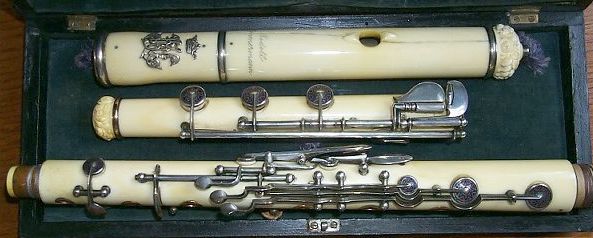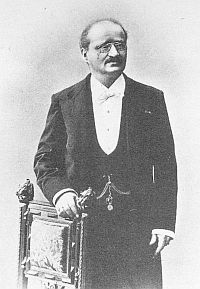

Ernesto Köhler (1849–1907) was born in Italy, spent two years in Vienna, and then, at the age of 22, joined the Imperial Theater in St. Petersburg, where he remained until he died. He was one of the most well known flutists of his time. He published many works for flute and a popular method, his Flöten-Schule of c.1880. Even though Köhler was born after the invention of the cylindrical Boehm flute, he declined to adopt it and played the old-style flutes his entire life.
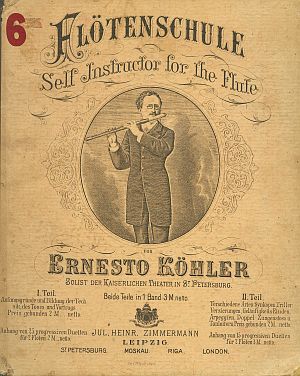
The 1899 catalog of the firm of Jul. Heinr. Zimmermann contains the following endorsement, by Ernesto Köhler, of the "Modell Zimmermann" flute.
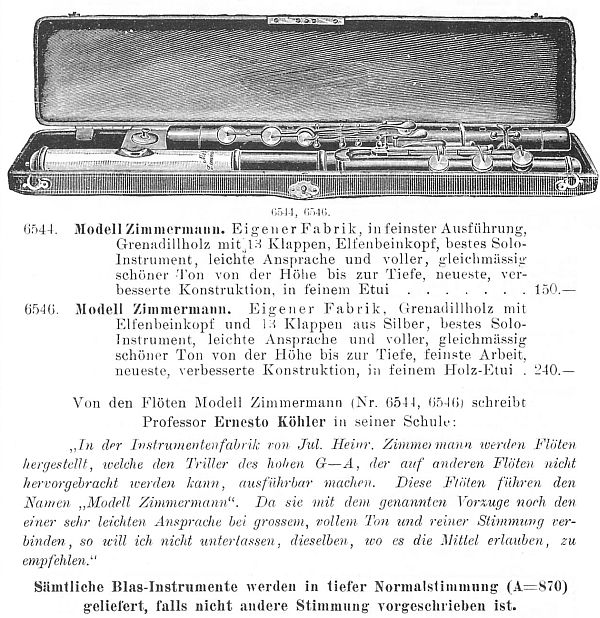
Translation of Köhler's statement:
In the instrument workshops of Jul. Heinr. Zimmermann, flutes are manufactured which make possible the high g'''-a''' trill, which trill cannot be done on other flutes. These flutes bear the name "Modell Zimmermann". Since they combine very easy speech and the above-mentioned advantage with a large, full tone and pure intonation, I do not hesitate to recommend this model, when the means permit it.
(Note that Zimmermann supplied instruments at A=435, unless otherwise instructed, in 1899.)
Here is another illustration of the Modell Zimmermann from the catalog:

... and an actual instrument:

The flute shown above was made somewhat later than 1899, perhaps circa 1915. The original head joint, unfortunately, is lost, and the one shown above was with the instrument when it was acquired a few years ago. Zimmermann had offices in Leipzig, St. Petersburg, Moscow, Riga, and London. This instrument is stamped (in Cyrillic, at the top of the center joint) Julius Heinrich Zimmermann / St. Petersburg.
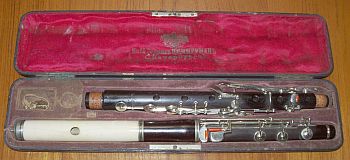
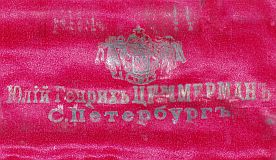
That Köhler endorsed the Modell Zimmermann does not necessarily mean that he played this instrument (or any flute by Zimmermann) himself. Zimmermann was the publisher of his Flöten-Schule and I am sure he was happy to put in a good word for their instruments. It is concievable that Köhler would have prefered Viennese-style instruments, since he spent time in Vienna, and this was the type of instrument favored by 19th century Italian flutists. Below is a Viennese-style instrument, also by the Zimmermann firm and also stamped in Cyrillic (and also with a non-original head).

It is hard to see differences in the small photos, but compare, for example, the construction of the foot joint keys at the far end (right side).
The Modell Zimmermann is, at least externally, almost exactly the same as the Schwedlerflöte, introduced in 1885 by flutist Maximilian Schwedler of the Leipzig Gewandhaus orchestra, and the builder Carl Kruspe. Zimmermann has copied every feature of the latter's instrument except Schwedler's special trill key for d''' and other trills (instead retaining an older form of a d''' trill key and also a large, extra G# key). In particular, the trill key for g''' praised by Köhler was first found on the 1885 Schwedlerflöte. Thus it is not accurate to say that the trill could not be done on other flutes. For those with good eyes and who may be interested, the touch for this g''' trill key is the narrow cross bar between finger holes 4 and 5 to be seen on the Modell Zimmermann, but not on the Viennese-style flute; it opens two holes high up on the instrument by means of an axle.
Another prominent feature of the Schwedlerflöte that was borrowed by Zimmermann is the Schwedler-Mundloch, the raised cusps on the right and left of the embouchure hole. This can be seen in the engravings above, but not the photograph (since the original head is lost). This is visible on the Modell Zimmermann below, which is said to have belonged to Tsar Nicolas II, and which now belongs to Jean-Pierre Eustache.
